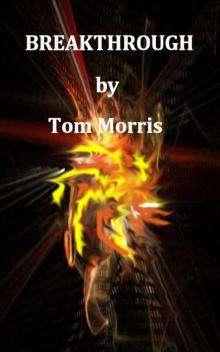


Breakthrough
Tom Morris

BREAKTHOUGH
by
Tom Morris
Copyright 2012, Tom Morris
All places, characters and events in this publication other than those clearly in the public domain are fictitious and any resemblance to real persons, living or dead, is purely coincidental.
CERN, the European Organization for Nuclear Research, is one of the world’s largest and most respected centres for scientific research. Its business is fundamental physics, finding out what the Universe is made of and how it works. At CERN, the world’s largest and most complex scientific instruments are used to study the basic constituents of matter - the fundamental particles. By studying what happens when these particles collide, physicists learn about the laws of Nature.
The Large Hadron Collider (LHC) is a gigantic particle accelerator near Geneva, spanning the border between Switzerland and France about 100m underground. It is revolutionising our understanding, from the minuscule world deep within atoms to the vastness of the Universe. Two beams of subatomic particles travel in opposite directions, accelerated by giant magnets cooled with liquid helium to just a few degrees above absolute zero, to almost light speed and then collide head-on releasing immense bursts of energy.
For the first few decades of the 21st century teams of scientists at CERN tried to establish a greater understanding of the fundamental particles which make up the Universe and the interactions between them. With the existence of such esoteric forms of matter such as the Higgs Boson and the quark-gluon plasma predicted by quantum chromodynamics having been established much of the initial work set out in the early programmes has almost been completed. However recent developments in M Theory based on Calabi-Yau n- manifolds have shown that the concept of a universe based on multiple dimensions should be amenable to experimental proof if only sufficiently high energy could be attained and thus the main thrust of work at CERN has been to delve deeper into this fascinating field with the initiation of Project Breakthrough.
Abstract of promotional literature, Pan European Association for Nuclear Research, April 2022
***********
ACCIDENT AT THE LARGE HADRON COLLIDER HALTS RESEARCH PROGRAMME.
It is understood that an incident occurred yesterday at CERN during a high energy experiment using the High Energy Collider. It is believed that an undescribed overload partly destroyed the main detector and shut down the central computing network. There is an unconfirmed report that at least one of the personnel involved sustained injuries although to what degree is unknown.
Newsflash – Reuters International News Agency, 13-05-2025.
***********
To Gustav Behringer, Head of High Energy Operations – Project Breakthrough
(Confidential – Not For Release).
Preliminary Incident Report, LHC, Friday 13th May 2025
Following the protocols derived from the preliminary experimental programme aimed at establishing a trans-dimensional event the LHC was re-jigged by the engineering team in order to attain a higher energy input into the target. The system was enabled and build up started at 09.45. By 13.30 the particle beams had achieved a 15.3 TeV (tera-electronvolt) energy status and magnetic switching was initiated to focus the beam collision at detector AHD/23-C. Records show that initially a localised high energy plasma was induced as intended and preliminary analysis indicated the formation of a super-gravity matrix field and dimensional instability occurring. At 13.47 an immediate and rapid energy surge occurred and at this point the alarm system activated, shunting the particle beams away from the target. There was a simultaneous malfunction of the detector and the control computer and this system crashed. Several of the personnel present reported that just prior to this incident there was an effect which they describe as the appearance of the room "warping" or twisting and of a feeling of disorientation as to what was up and down. Whether this was real or imagined is unclear. Once the necessary procedures had been carried through to establish that a safe status had been achieved an investigation commenced to determine the nature of the problem.
Adam Delgarde, the team leader, opened the inspection panels and was in the process of connecting diagnostic equipment into the mainframe access hardware when it appears he suffered what was believed to be an electric shock as he convulsed and was hurled backwards into the room where he collapsed onto the floor. It must be stated that his team members are adamant that Adam had taken the necessary precautions to ensure that the equipment was isolated and that tests had been made to determine this. Medical assistance was immediately summoned and first aid given. It was established that although unconscious he did not seem to have suffered any sever trauma and that his heart was functioning normally. It was not possible however to rouse him. He was therefore taken by ambulance to the Hopital Generale de Geneve for treatment.
A full investigation is underway and hopefully Adam Delgarde will soon recover so that a statement may be taken.
Signed: Antoine deBec: Chef du Département de la Santé et la Sécurité. CERN
***********














